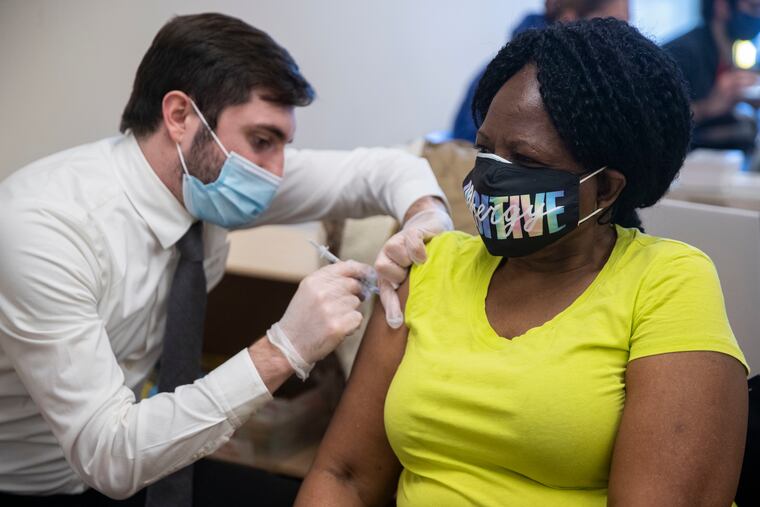Vaccines already brought good news. Better messaging can bring more. | Opinion
Trusted medical providers and those who already got the vaccine can convince others to take the shot.

Pfizer. Moderna. Johnson & Johnson. One vaccine after another is proving effective against symptomatic COVID-19, and the possibility of hospitalization or death from it. Although these reports are encouraging, it is not effective vaccines but rather shots in arms that will end the pandemic. While the results differ from survey to survey, the percentage of those expressing reluctance to take the COVID vaccine remains high enough to raise concerns that communities, particularly those of color, will fail to reach the level of immunity needed to stop the pandemic.
A December Kaiser Family Foundation survey of U.S. adults finds unwillingness to take the vaccine is driven by worries about side effects, lack of trust in the government to ensure the safety and effectiveness of the vaccines, and concerns that the vaccines are too new or that politics affected their development. Among hesitant Black adults, two other concerns surfaced: a distrust of vaccines in general, and worry that one can get COVID-19 from them.
Hand-wringing is not the answer. Instead, the medical community needs to enlist two types of credible ambassadors: trusted medical providers, and the millions of individuals who are lining up for their own COVID-19 shots. Because 85% of the U.S. public reports trusting vaccine information from their own doctor or health-care provider, these professionals should spread the word that they and their families are eagerly taking the vaccine.
» READ MORE: Vaccine hesitancy is decreasing, polls show, but many Republicans remain wary
Trust is key to our second form of vaccine ambassadorship as well. Before each of us received our first dose, we signed consent forms focused on potential side effects. As we rolled down our sleeves, we were each handed a printout. This sheet contained details about symptoms we might experience as our bodies mounted a defense, a warning to avoid receiving other vaccines for two weeks, and information on how to report “adverse reactions.”
But instead of turning us into vaccine champions, the consent form and that Post-Visit Instruction Sheet focused on potential complications — messages that, if shared, could reinforce the reluctance of vaccine-hesitant loved ones.
We propose transforming the long queues to get the vaccination, the 15-minute postvaccination safety monitoring period, and the blank page on the back of the take-home instruction sheet into a constructive public health experience.
The blank side of the take-home side effects handout could be filled with answers to frequently asked questions about how the vaccines work, about the size of the clinical trials and the diversity of the studied populations, and about the rigor with which the vaccine data were reviewed by independent scientists and doctors with no ties to the vaccine makers. A Q&A format could dispatch misconceptions such as the misbelief that a vaccine can give a recipient COVID-19, using a reliable informational technique known as inoculation that exposes the reader to a form of reservation and rebuts it: “Some people mistakenly think that the COVID-19 vaccine can give you COVID-19, but since the vaccine does not contain the novel coronavirus, that is impossible.”
Those who have engaged in an unfamiliar behavior are disposed to talk with others about it, and in the process justify it. As a result, bolstering the recipient’s knowledge and confidence in COVID-19 vaccination in these ways should increase the chances that those subsequent conversations spread enthusiasm for vaccination, not wariness about it.
» READ MORE: Should the government pay people to take the COVID-19 vaccine? | Pro/Con
This information could be underscored with engaging posters on the walls of facilities where people receive vaccines. As they physically distance from those ahead and behind them in line, our prospective vaccine recipients might benefit from reading posters such as the CDC’s “What to Expect,” which emphasizes that the vaccine is a tool that, along with distancing and masking, will help control the pandemic. A second poster could remind passersby that smallpox, measles, pertussis, and diphtheria are now almost unheard of because of vaccination, and that vaccination has probably saved more lives than any other public health intervention, save perhaps sanitation. A third poster might show how the FDA determines that a vaccine is as safe as possible and less risky than getting COVID-19.
This strategy would marry motive, opportunity, means, and message.
Motive: Humans seek out information that justifies their behavior.
Opportunity: Time in line and awaiting discharge.
Means: Must-read messages with salient information and, in our case, a blank second side that could be utilized.
Message: Content that reinforces the value of vaccination, allays concerns, and dispatches misconceptions.
The COVID-19 vaccination experience is an opportunity to “inoculate” recipients twice — once in the arm against the virus, and once psychologically, increasing their resistance to anti-vaccination claims and equipping them to engage in pro-vaccination advocacy. Marshaling local health-care providers and those who have been newly vaccinated to preempt the spread of misconceptions provides two inoculations for the price of one.
David Scales is an assistant professor of medicine at Weill Cornell Medical College and chief medical officer of Critica. The views expressed in this piece are those of the authors and do not necessarily reflect the official position of Weill Cornell. Jack Gorman is president and cofounder of Critica, a nonprofit organization seeking to center the role of science in making rational health decisions. Kathleen Hall Jamieson is the director of Penn’s Annenberg Public Policy Center and cofounder of FactCheck.org.